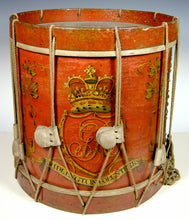Side Drum of the Bridlington Volunteers by Robert Horne, Circa 1794
Adding product to your cart
Diameter 40cm (16in) Height: 46cm (18in) high
The interior of the drum bears the 18th century maker's label of Robert Horne, this being visible through the breather hole at the centre of 'tack' pattern (this being the arrangement of tacks that holds the cylinder together). The tack pattern present is known as the ‘King’s Landing’ tack pattern, after a drum with the same tack pattern found at King's Landing, New Brunswick, Canada. Another 18th century drum now in Norway, but most certainly British in origin, has been identified by military historian Warren Simpson as having the same tackwork. The closest comparable example to the present drum is another example by Robert Horne that was captured by American forces from the British 41st Regiment of Foot at the Battle of the Thames at London, Ontario during the War of 1812. It is now on display in the Kentucky National Guard Museum. (Enter ‘drum’ in search box at http://history.ky.gov/military/)
Read more
The original maker’s label of Robert Horne: within a rococo cartouche flanked by a fifer and a drummer wearing mitred caps. The whole surmounted by side drum and trophy of arms - ‘Robert Horne / Drum maker to His Majesty’s office of Ordnance / No. 20 Barbican LONDON / side drums of wood or brass, kettle / & bass drums tambourines / standards colours / drum major trophies / fifes and cases etc’. 19th century labels relating to restoration of the drum in 1891 by A.J. Stevenson who appears to have been in the hardware business from the trade labels used. On one of the trade labels Stevenson has written ‘This drum was bought at the Lawson Sale, leather merchants, 1891’. On the next ‘Two new drum heads fixed Thursday November 30th 1893’. The next label is dated in manuscript ‘December 7th 1891’ ‘This drum was repaired December 7/1891 by Albert James Stevenson and R.H. Aldridge’
The Bridlington Volunteers were formed in 1794 following the outbreak of the war with Revolutionary France. The corps was to consist of 20 artillerymen (later increased to 50) and a company of infantry, all under the under the command of Captain John Pitts. Its purpose was to man the fort at Bridlington Quay in the event of a landing or raid on the harbour by French forces. Additionally its presence as part of the militia of the East Riding of Yorkshire would deter the seditious activity of anti-royalists sympathetic to French revolutionary principles. It was uniformed in blue, and was disbanded in its first incarnation in 1801. Following the renewal of war, now with Napoleonic France, and the heightened risk of invasion, the Bridlington Volunteer Artillery was formed under Major David Taylor with an establishment of 100 men - its uniform being blue with red facings. The Bridlington Volunteer Infantry was also formed at the same time and was again commanded by Lieutenant-Colonel John Pitts. Its uniform this time was scarlet with yellow facings and white knee breeches. With the passing of the invasion threat and after five years in service it was disbanded to the militia in 1808.
A report of the raising of the volunteers in 1794 ran as follows: 'At a meeting of Nobles, Gentlemen, Clergy, Freeholders and Yeomen of the Riding ... held at Beverley on Wednesday, 30th day of April, 1794, pursuant to public advertisement for taking into consideration measure necessary to be adopted for the Internal Defence ...it was resolved: That we are ready and willing at all times to stand forward in support of our King and Glorious Constitution and that in the present crisis it is expedient to provide for Internal Defence ... That the fort at Bridlington Quay be put into repair out of subscription and the Government be applied to, for the supply of Ordinance and Ammunition, and also such Naval Force to be stationed on the coast as thought necessary ...'




